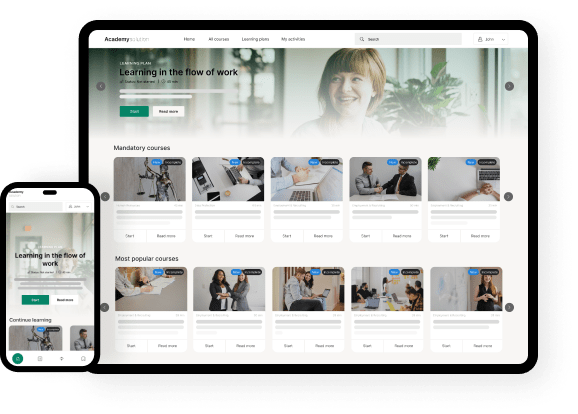The world is swiftly changing, and, in a few years, non-digital businesses will phase out as technology continues to play a vital part in most industries.
If you’re a consultant still selling your expertise via analog distribution channels, you need to prepare for the future by productizing your service. And the sooner you start accelerating your business’ digital readiness, the better.
Here are three signs you’re ready to digitally transform your analog business with an online academy.
First sign: Content production and management has become a hurdle
When the fundamental activities of running your business, such as producing, updating, and distributing content has become a hurdle, you need to act immediately.
Maybe you’re relying on too many different third-party tools that makes your processes more complicated than necessary. Or maybe you don’t have enough team members to uphold or scale your operations. It could of course also be a combination of the two.
Content production, management, and distribution is crucial not only for your daily operations but also for your business’ scalability.
Unfortunately, scalability is a common issue in the service realm. Scaling a knowledge business can be a real uphill battle if you can’t afford to take on new consultants or don’t have the time and resources to train them. But even if you are capable of adding new employees to your team, your costs are bound to continually increase. And we all know that tuning your pricing proportionally along with your costs isn’t always an option.
Productizing your service by going from analog to digital business operations can ease your daily work process and foster better scaling opportunities at the same time. Here’s why:
Running a knowledge business is simpler with an all-in-one solution
Going digital means, you get to gather all content production, management, and distribution under one roof.
Ditching all third-party tools will maximize the effectiveness of your work and give you a much more streamlined work process.
As opposed to delivering your knowledge as an analog service, you don’t have to worry about format, time, or location when productizing your service. And long commutes, booking of physical classrooms and meeting rooms, as well as reserving hotel rooms for seminars and conferences that requires an overnight stay is now long-forgotten. But maybe most importantly, digitizing your business ensures consistency.
Scaling is easier when you’re not dependent on that extra pair of hands
When productizing your service with an online academy you’re not dependent on your consultants to be able to deliver your content; your content is automatically delivered to your audience with the click of a button.
This likewise speak into the consistency of your output. When your service becomes duplicatable and operation costs cheaper, you’re able to scale your product as demand grows. And with a digitized process you’re able to scale your business without hiring more employees.
Second sign: How we learn has changed
The pandemic has brought to us lockdowns, restrictions, work-from-home orders, and of course it has contributed to the reluctance of gathering in bigger groups.
On the assumption that you like many other analog knowledge businesses out of a sudden became limited in your operations, you ought to reconsider your entire business foundation.
Although the pandemic ensured you couldn’t serve your customers in-person as usual, your service definitely didn’t become redundant. No matter what, the need for corporate learning and development will never seem to cease. You just need to find a way to sustain a steady delivering method. And to no ones’ surprise, we of course recommend going digital.
All the indications are to be found in the way our society has evolved in the past years and will continue to transform in the future. Let’s look at three conditions that pose as clear signals for you to productize your service with an online academy:
#1: The pandemic
As COVID-19 made its grand entry, offices emptied and employees set up remote work desks within their homes. Moreover, physical classrooms and meeting rooms previously used in relation to onboarding and compliance management training was no longer safe to use.
To stop or at least slow down the spread of COVID-19 we turned to digital solutions.
If organizations didn’t already have a unified communication or collaboration (UC&C) tool, they adopted one.
The interest and usage of digital platforms such as Microsoft Teams, Zoom, and Google Meet skyrocketed as daily work tasks as well as learning and development initiatives were taken online.
Going digital meant that organizations in a time of huge uncertainty still could continue their operations and feed their employees necessary information and knowledge.
#2: Our work-life balance
While it might seem like COVID-19 accelerated the work-from-home movement, the shift to remote work was already well underway.
Before the pandemic hit, remote work had been growing hastily. In fact, numbers show that remote work saw a 159 percent growth over the last 12 years before the pandemic started.
This is further backed by research showing that while small and medium-sized businesses (SMBs) notice greater differences when comparing pre-pandemic operations to today’s, large enterprises notice little difference.
Many large enterprises already had advanced technology and work-from-home policies well before the pandemic occurred, whereas SMBs were hit harder by remote work and still face the challenge of optimizing the productivity of a fully remote workforce. In fact, the number of SMBs that plan to deploy or currently are deploying Microsoft Teams within the next two years has increased by a staggering 103 percent.
The bottom line is, nevertheless, that sources show many organizations have realized that physically being at the office full-time isn’t the key to producing great results. And at the same time, having a choice of when and where to work and learn is a key factor for many employees when trying to establish a better work-life balance.
Putting knowledge at the fingertips of learners through digital tools such as an online academy therefore isn’t such a bad idea after all. In any case, it is in huge demand.
#3: Innovation and modernism
In the knowledge industry, you will always see new trends and drivers.
Every learner has a different learning style. Some are best suited to learn through visual stimulation. Others may learn better through hands-on education. And whereas one learning method is popular this week, another one might be gaining traction next week.
Operating within the knowledge industry requires flexibility. And this is where an online academy comes into play.
As employers and employees are looking for more effective training opportunities, more agile solutions are needed. No organization can afford to fall behind when it comes to learning and development. Not if they themselves want to stay on top of their game at least.
It therefore comes as little surprise that the mobile learning market is projected to reach nearly $58 billion by 2025.
A digital distribution channel allows for much quicker reaction and respond times than an analog distribution channel because computerized alternations often are easier to conduct than analog changes.
Thus, undergoing a digital transformation will often times lead to greater satisfaction among customers and a better and higher reputation for the knowledge provider.
Third sign: You want to scale your business not grow it
Although starting a service business usually doesn’t require a lot of capital, they are notoriously hard to scale.
Knowledge businesses exchange time for money, usually to one customer, or at most a handful of customers. For example, a consultant could get paid hourly to pass on their expertise to a single client.
To earn more money, they need to invest more hours into serving new clients. And this is exactly what makes it very difficult for a service business to scale.
Most service businesses keep their team at a few dozen people in order to keep personal relationships with everyone and monitor performance and quality on a one-on-one basis. You could of course add more consultants to your team, but this would technically not be scaling the company. This method will only expand total revenue.
That is because growth means to add new resources such as capital, people, or technology and have your revenue increase as a result. And by contrast, scaling is when revenue increases without a substantial increase in resources.
If this is something you’ve found yourself battling with, productizing your service with an online academy could be the answer you’re looking for. Here are the reasons why:
A productized service stands on its own
To transform you service into a product, you must draw on your accumulated experience to convert your customized services into packaged solutions that stand on their own, and which can be used by the customer without much seller support.
In short, productized services are standardized services that are packaged and marketed like ready-made products. So, while it doesn’t necessarily involve a physical product, it’s sold like one.
And the key here is that a you can sell your productized service to multiple customers without requiring additional time from you.
It’s easier to creative recurring revenue
Not all services are needed on a recurring basis. But by productizing your service, you can keep customers longer by providing recurring plans that they have to sign up for on a regular basis. And then there is of course the option to upsell via upgrades and add-on services.
When it comes to income streams, one-off projects are usually harder to predict because they’re more complex. With a recurring revenue, you have everything laid out in advance which will let you know how your future revenue looks like.
Moreover, recurring revenue is more lucrative and scales better over time seeing that the cost of billing, accounting and so on is lower.
The perceived value is usually higher
Selling products is very different from selling services.
For customers, it’s often easier to perceive the value of a neatly packed and marketed product than a more fluffy and intangible service offering.
That is of course only as long as you keep your pricing simple and easy for customers to understand.
And the difference between surviving and thriving is to identify and price along your proper value metric. And by choosing a value metric that scales with customers’ usage of your product should ensure that your pricing can and will scale with your growth.
How to proceed with digital transformation
If you can relate to any of the abovementioned signs, it’s time for you to ditch your analog distribution channels and turn to digital ones instead.
Provided that digital transformation has you trembling a bit, fear not. Although taking your knowledge online does in fact sound overwhelming, it doesn’t have to be.
To get started you simply book a free demo with us. We’ll talk about what obstacles you’re facing and together we’ll find a solution that’ll future-proof your business.
All we essentially need from you is to know how you’d like to brand your online academy. We’ll take care of all the technical stuff. It really couldn’t be more easy-peasy-lemon-squeezy to welcome technology into your business.
Let us help you prepare for the future.


